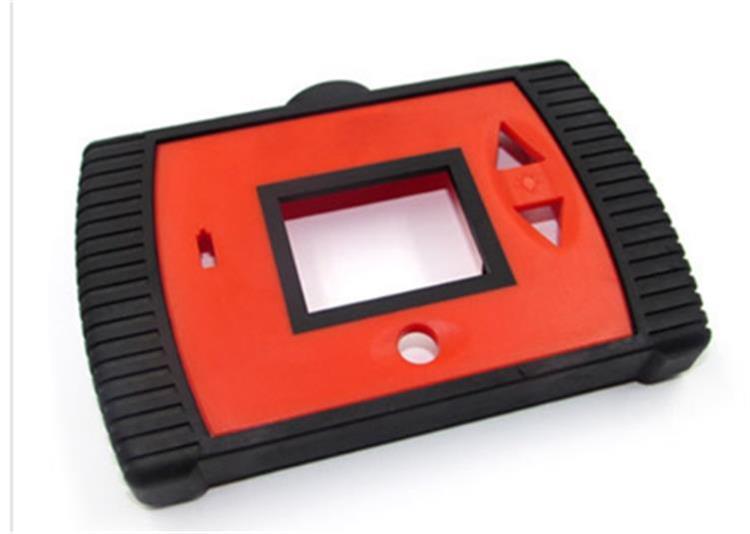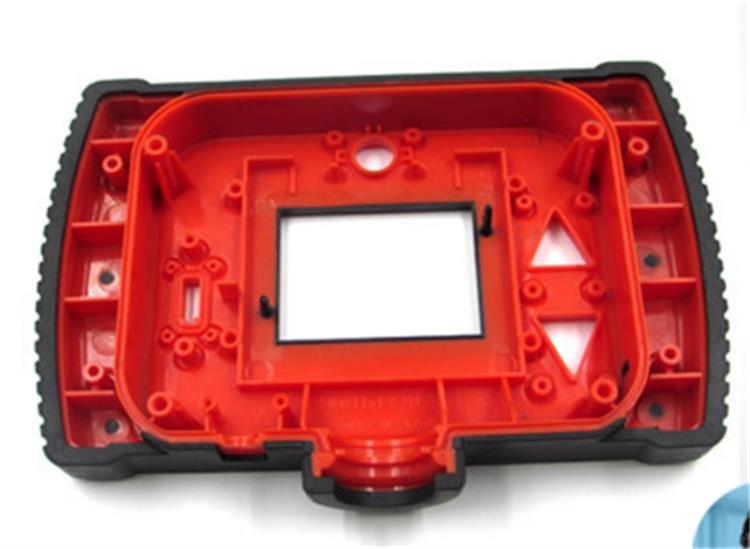Overmolding injection process is used in many areas to create finished plastic parts and improve product efficiency. Without the process of,we would not have so many consumer products that everyone wants and needs. Examples of
overmolded products would be packing products,cell phones, toothbrush, computer monitors. So how exactly does the overmolding process work and what kind of defects we may see?

What is overmolding?
Overmolding is also called as
two-shot molding, results in parts in which it is clearly evident that more than one material is being used. It is a kind of
injection molding process where only part of a product is molded in one material, and that molded piece is manipulated so the second material can be molded around, over, under, or through it to complete the final part. This method is sometimes referred to as in-mold assembly, since the resulting part effectively acts as an assembly of two materials rather than as a layered structure
Overmolding is the an injection molding process using two separate injection molds of which you mold one material over another to create or touch appeal such as a handle or knob. This is done using certain plastics and polymers. Typically research has shown that PE (polyethylene) is the most widely used plastic in the
over molding process. It is used because it can be drawn out into thin sheets which makes the
overmolding process easier and more efficient.
Types of Overmolding
There are two basic types of
overmolding used in industrial processes today. The first is the insert molding process which “the rigid substrate is molded first and transferred to a second mold, where a thermoplastic elastomer (TPE) is shot around the insert to create the finished part. The process uses standard injection molding machines and relatively simple, low-cost tools.
Insert molding is best suited to applications involving relatively low volumes and manufacturing locations where labor costs are low”. The second process involves a term called
multi-shot molding which basically works off of the same principles that insert molding does but uses many insert molders to shot a compound into a mold. this process is typically used when there is more production being done and manufactures want to be more economically cautious.
As know, with overmolding process, a TPE is injection molded over or around a compatible substrate using either insert or multi-shot processes. The resulting hard-soft structures are quite effective in comfortable, non-slip, and abrasion-resistant handles, grips, and buttons. A critical challenge for designers and producers of these parts is poor adhesion of TPE to substrate, which reveals itself in peeling, curling, or delamination of the material layers.
Defects and potential problems with overmolding
Temperature is one of them and probably second most important to the components. Temperature affects the thermoplastics greatly and if these temperature are not exactly correct then the whole process and
overmolding line can be ruined, wasting product materials as well as energy and time for the consumer. “The relationship between temperature of the TPE melt and adhesion strength is reflected in the example of a 65 Shore A TPE overmolded on a PC substrate. As the melt temperature increases from 370 F to 400 F, a notable improvement in adhesion strength is evident. But a further increase to 430 F actually reduces adhesion strength. In this instance, the optimum melt temperature is somewhat less than 400 F. Molders must balance desired adhesion strength against the possible adverse effects of elevated melt temperature, e.g., thermal degradation and ejection difficulty.”
 Ten Tips on Overmolding
Ten Tips on Overmolding
- Match compatibility of TPE and substrate.
- Minimize peeling with sharp transitions in shut-off design.
- Avoid trapping air in cavities via appropriate venting.
- Balance TPE thickness with Shore A hardness for desired “feel.”
- Maintain TPE melt temperature at the level that optimizes adhesion.
- Dry moisture-sensitive materials.
- Select color-concentrate carriers that are compatible with both the TPE and substrate.
- Be aware of liabilities of smooth surface textures.
- Keep the TPE flow-length/part- thickness ratio below 150:1.
- Design gating with good adhesion
In short,
overmolding is a highly useful process in which one can combine two different molds for either appearance reasons or durability. Without the
overmolding process the items and consumer parts that we use everyday such as cell phones, automotives and thousands of other parts would not exist. For technical discussions of over molding, please contact hsmolds.net!
 What is overmolding?
Overmolding is also called as two-shot molding, results in parts in which it is clearly evident that more than one material is being used. It is a kind of injection molding process where only part of a product is molded in one material, and that molded piece is manipulated so the second material can be molded around, over, under, or through it to complete the final part. This method is sometimes referred to as in-mold assembly, since the resulting part effectively acts as an assembly of two materials rather than as a layered structure
Overmolding is the an injection molding process using two separate injection molds of which you mold one material over another to create or touch appeal such as a handle or knob. This is done using certain plastics and polymers. Typically research has shown that PE (polyethylene) is the most widely used plastic in the over molding process. It is used because it can be drawn out into thin sheets which makes the overmolding process easier and more efficient.
Types of Overmolding
There are two basic types of overmolding used in industrial processes today. The first is the insert molding process which “the rigid substrate is molded first and transferred to a second mold, where a thermoplastic elastomer (TPE) is shot around the insert to create the finished part. The process uses standard injection molding machines and relatively simple, low-cost tools. Insert molding is best suited to applications involving relatively low volumes and manufacturing locations where labor costs are low”. The second process involves a term called multi-shot molding which basically works off of the same principles that insert molding does but uses many insert molders to shot a compound into a mold. this process is typically used when there is more production being done and manufactures want to be more economically cautious.
As know, with overmolding process, a TPE is injection molded over or around a compatible substrate using either insert or multi-shot processes. The resulting hard-soft structures are quite effective in comfortable, non-slip, and abrasion-resistant handles, grips, and buttons. A critical challenge for designers and producers of these parts is poor adhesion of TPE to substrate, which reveals itself in peeling, curling, or delamination of the material layers.
Defects and potential problems with overmolding
Temperature is one of them and probably second most important to the components. Temperature affects the thermoplastics greatly and if these temperature are not exactly correct then the whole process and overmolding line can be ruined, wasting product materials as well as energy and time for the consumer. “The relationship between temperature of the TPE melt and adhesion strength is reflected in the example of a 65 Shore A TPE overmolded on a PC substrate. As the melt temperature increases from 370 F to 400 F, a notable improvement in adhesion strength is evident. But a further increase to 430 F actually reduces adhesion strength. In this instance, the optimum melt temperature is somewhat less than 400 F. Molders must balance desired adhesion strength against the possible adverse effects of elevated melt temperature, e.g., thermal degradation and ejection difficulty.”
What is overmolding?
Overmolding is also called as two-shot molding, results in parts in which it is clearly evident that more than one material is being used. It is a kind of injection molding process where only part of a product is molded in one material, and that molded piece is manipulated so the second material can be molded around, over, under, or through it to complete the final part. This method is sometimes referred to as in-mold assembly, since the resulting part effectively acts as an assembly of two materials rather than as a layered structure
Overmolding is the an injection molding process using two separate injection molds of which you mold one material over another to create or touch appeal such as a handle or knob. This is done using certain plastics and polymers. Typically research has shown that PE (polyethylene) is the most widely used plastic in the over molding process. It is used because it can be drawn out into thin sheets which makes the overmolding process easier and more efficient.
Types of Overmolding
There are two basic types of overmolding used in industrial processes today. The first is the insert molding process which “the rigid substrate is molded first and transferred to a second mold, where a thermoplastic elastomer (TPE) is shot around the insert to create the finished part. The process uses standard injection molding machines and relatively simple, low-cost tools. Insert molding is best suited to applications involving relatively low volumes and manufacturing locations where labor costs are low”. The second process involves a term called multi-shot molding which basically works off of the same principles that insert molding does but uses many insert molders to shot a compound into a mold. this process is typically used when there is more production being done and manufactures want to be more economically cautious.
As know, with overmolding process, a TPE is injection molded over or around a compatible substrate using either insert or multi-shot processes. The resulting hard-soft structures are quite effective in comfortable, non-slip, and abrasion-resistant handles, grips, and buttons. A critical challenge for designers and producers of these parts is poor adhesion of TPE to substrate, which reveals itself in peeling, curling, or delamination of the material layers.
Defects and potential problems with overmolding
Temperature is one of them and probably second most important to the components. Temperature affects the thermoplastics greatly and if these temperature are not exactly correct then the whole process and overmolding line can be ruined, wasting product materials as well as energy and time for the consumer. “The relationship between temperature of the TPE melt and adhesion strength is reflected in the example of a 65 Shore A TPE overmolded on a PC substrate. As the melt temperature increases from 370 F to 400 F, a notable improvement in adhesion strength is evident. But a further increase to 430 F actually reduces adhesion strength. In this instance, the optimum melt temperature is somewhat less than 400 F. Molders must balance desired adhesion strength against the possible adverse effects of elevated melt temperature, e.g., thermal degradation and ejection difficulty.”
 Ten Tips on Overmolding
Ten Tips on Overmolding



 Español
Español